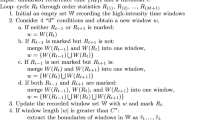Abstract
Real time series sometimes exhibit various types of “irregularities”: missing observations, observations collected not regularly over time for practical reasons, observation times driven by the series itself, or outlying observations. However, the vast majority of methods of time series analysis are designed for regular time series only. A particular case of irregularly spaced time series is that in which the sampling procedure over time depends also on the observed values. In such situations, there is stochastic dependence between the process being modelled and the times of the observations. In this work, we propose a model in which the sampling design depends on all past history of the observed processes. Taking into account the natural temporal order underlying available data represented by a time series, then a modelling approach based on evolutionary processes seems a natural choice. We consider maximum likelihood estimation of the model parameters. Numerical studies with simulated and real data sets are performed to illustrate the benefits of this model-based approach.




Similar content being viewed by others
Notes
This point process is stationary under the conditions given by Proposition 6.4. VII. from Daley and Vere-Jones (2003)
We use package yuima, with \(S_0=0\) and a discretization of time domain in 1600 points equally spaced.
Recall \(\omega \) is a reparametrization of \(\sigma \), defined in Eq. (12).
\(\hbox {MAPE}=\frac{1}{R}\sum \nolimits _{r=1}^{R}\frac{\left| t_{54}-{\widehat{t}}_{54,r}\right| }{t_{54}}\times 100\%\)
\(\hbox {MAE}=\frac{1}{R}\sum \nolimits _{r=1}^{R} \left| t_{54}-{\widehat{t}}_{54,r}\right| \)
References
Box GE, Jenkins GM, Reinsel GC, Ljung GM (2015) Time series analysis: forecasting and control. Wiley, Hoboken
Brockwell PJ, Davis RA (2002) Introduction to time series and forecasting. Springer, Berlin
Daley DJ, Vere-Jones D (2003) An introduction to the theory of point processes. Elementary theory and methods, vol 1, 2nd edn. Springer, New York
Daley DJ, Vere-Jones D (2008) An introduction to the theory of point processes. General theory and structure, vol 1, 2nd edn. Springer, New York
Daniels MJ, Hogan JW (2008) Missing data in longitudinal studies: strategies for Bayesian modeling and sensitivity analysis. CRC Press, Boca Raton
Diggle P, Kenward MG (1994) Informative drop-out in longitudinal data analysis. J R Stat Soc Ser C (Appl Stat) 43:49–93
Hawkes AG (1971) Spectra of some self-exciting and mutually exciting point processes. Biometrika 58(1):83–90
Hogan JW, Laird NM (1997) Model-based approaches to analysing incomplete longitudinal and failure time data. Stat Med 16(3):259–272
Kristensen K, Nielsen A, Berg CW, Skaug H, Bell BM (2016) TMB: automatic differentiation and Laplace approximation. J Stat Softw 70(5):1–21. https://doi.org/10.18637/jss.v070.i05
Lapham BM (2014) Hawkes processes and some financial applications. PhD thesis, University of Cape Town
Lewis PAW, Shedler GS (1979) Simulation of nonhomogeneous poisson processes by thinning. Naval Res Logist Q 26(3):403–413
Liang Y, Lu W, Ying Z (2009) Joint modeling and analysis of longitudinal data with informative observation times. Biometrics 65(2):377–384
Lindgren F, Rue H, Lindström J (2011) An explicit link between gaussian fields and gaussian markov random fields: the stochastic partial differential equation approach. J R Stat Soc Ser B (Stat Methodol) 73(4):423–498
Monteiro A, Menezes R, Silva ME (2018) Modelling irregularly spaced time series under preferentail sampling. RevStat Stat J (accepted)
Monteiro A, Menezes R, Silva ME (2019) Modelling preferential sampling in time. BEIO 35(3):180–196
Ogata Y (1981) On Lewis’ simulation method for point processes. IEEE Trans Inf Theory 27(1):23–31
Rasmussen JG (2013) Bayesian inference for Hawkes processes. Methodol Comput Appl Probab 15(3):623–642
Ryu D, Sinha D, Mallick B, Lipsitz SR, Lipshultz SE (2007) Longitudinal studies with outcome-dependent follow-up: models and Bayesian regression. J Am Stat Assoc 102(479):952–961
Shumway RH, Stoffer DS (2017) Time series analysis and its applications: with R examples, 4th edn. Springer texts in statistics. Springer, New York
Stoffer D (2017) astsa: Applied statistical time series analysis. https://CRAN.R-project.org/package=astsa. Accessed Jan 2018
Wang Z (2013) cts: An R package for continuous time autoregressive models via Kalman filter. J Stat Softw 53(5):1–19
Acknowledgements
The authors acknowledge Foundation FCT (Fundação para a Ciência e Tecnologia) as members of the research project PTDC/MAT-STA/28243/2017 and Center for Research & Development in Mathematics and Applications of Aveiro University within project UID/MAT/04106/2019.
Author information
Authors and Affiliations
Corresponding author
Additional information
Publisher's Note
Springer Nature remains neutral with regard to jurisdictional claims in published maps and institutional affiliations.
Rights and permissions
About this article
Cite this article
Monteiro, A., Menezes, R. & Silva, M.E. Modelling informative time points: an evolutionary process approach. TEST 30, 364–382 (2021). https://doi.org/10.1007/s11749-020-00722-2
Received:
Accepted:
Published:
Issue Date:
DOI: https://doi.org/10.1007/s11749-020-00722-2




